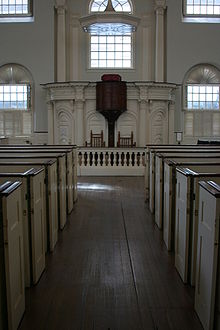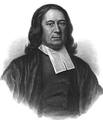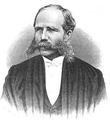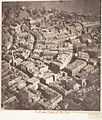- Old South Meeting House
-
This article is about the museum and historic site in Downtown Crossing. For the United Church of Christ church at Copley Square, see Old South Church.Old South Meeting House
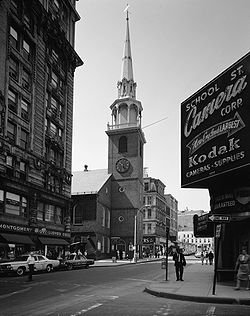 The Old South Meeting House, 1968
The Old South Meeting House, 1968Location: Boston, Massachusetts Coordinates: 42°21′25″N 71°3′31″W / 42.35694°N 71.05861°WCoordinates: 42°21′25″N 71°3′31″W / 42.35694°N 71.05861°W Built: 1729 Architect: Twelves,Robert Architectural style: Georgian Governing body: Private NRHP Reference#: 66000778[1] Significant dates Added to NRHP: October 15, 1966 Designated NHL: October 9, 1960 The Old South Meeting House (built 1729), in the Downtown Crossing area of Boston, Massachusetts, gained fame as the organizing point for the Boston Tea Party on December 16, 1773. 5,000[2] colonists gathered at the Meeting House, the largest building in Boston at the time.
Contents
History
Church (1729–1872)
The church, with its 56 m (183 ft) steeple, was completed in 1729. The congregation was gathered in 1669 when it broke off from First Church of Boston, a Congregationalist church founded by John Winthrop in 1630. The site was a gift of Mrs. Norton, widow of John Norton, pastor of the First Church in Boston.[3] The church's first pastor was Rev Thomas Thatcher, a native of Salisbury, England. Thatcher was also a physician and is known for publishing the first medical tract in Massachusetts.
After the Boston Massacre in 1770, yearly anniversary meetings were held at the church until 1775 featuring speakers such as John Hancock and Dr. Joseph Warren. In 1773 5,000 people met in the Meeting House to debate British taxation, and after the meeting a group raided a nearby tea ship in what became known as the Boston Tea Party.
In 1775 the British occupied the Meeting House due to its association with the Revolutionary cause. The British gutted the building, filled it with dirt and then used the interior to practice horse riding. They destroyed much of the interior and stole various items including William Bradford's Of Plymouth Plantation (1620), a unique Pilgrim manuscript, hidden in Old South's tower.
Old South Meeting House was almost destroyed in the Great Boston Fire of 1872, saved by the timely arrival of a fire engine from Portsmouth, New Hampshire, but the fire caused the city's residential districts to shift toward the Back Bay, away from the church. The congregation then built a new church (the "New" Old South Church at Copley Square) which remains its home to this day. Once a year, on the Sunday before Thanksgiving, the Old South congregation returns to Old South Meeting House for services in its ancestral home.
Ministers
- Thomas Thacher (1620–1678), minister 1670–1678[4]
- Samuel Willard (1640–1707), minister 1678–1707[5]
- Ebenezer Pemberton (1672–1717), minister 1700–1717[6]
- Joseph Sewall (1688–1769), minister 1713–1769[7]
- Thomas Prince (1687–1758), minister 1718–1758[8]
- Alexander Cumming (1726–1763), minister 1761–1763[9]
- Samuel Blair (1741–1818), minister ca.1766[10]
- John Bacon (b.1737), minister 1772–1775[11]
- Joseph Eckley (1750–1811), minister 1779–1811[12]
- Joshua Huntington (1786–1819), minister 1808–1819[13]
- Benjamin B. Wisner (1794–1835), minister 1821–1832[14]
- Samuel H. Stearns (1801–1837), minister 1834–1836[15][16]
- George W. Blagden (1802–1884), minister 1836–1872[17]
- Jacob M. Manning (1824–1882), minister 1857–1872[18]
Notable congregants
Museum (1877-present)
Old South Meeting House has been an important gathering place for nearly three centuries. Renowned for the protest meetings held here before the American Revolution when the building was termed a mouth-house, this National Historic Landmark has long served as a platform for the free expression of ideas. Today, the Old South Meeting House is open daily as a museum and continues to provide a place for people to meet, discuss and act on important issues of the day. The stories of the men and women who are part of Old South’s vital heritage reveal why the Old South Meeting House occupies an enduring place in the history of the United States.
The museum and historic site is located at the intersection of Washington and Milk Streets and can be visited for a nominal sum. It is located near the State Street, Downtown Crossing and Park Street MBTA (subway) stations.
The Old South Meeting House is claimed to be the second oldest establishment existent in the United States.
Images
-
Aerial photo of Financial District, showing Old South (center left), 1860 (J.W. Black)
See also
- New Old South Church, Copley Square, Back Bay, Boston
References
- ^ "National Register Information System". National Register of Historic Places. National Park Service. 2007-01-23. http://nrhp.focus.nps.gov/natreg/docs/All_Data.html.
- ^ John Galvin (Three Men of Boston. New York: Thomas Cromwell, 1976. 268.) puts that number as high as 8,000.
- ^ Bridgeman, Thomas (1856). The Pilgrims of Boston and their Descendants. New York: D. Appleton and Company. pp. 54–58. http://books.google.com/books?id=oPQWAAAAYAAJ&printsec=frontcover&dq=the+pilgrims+of+boston. Retrieved 29 April, 2009.
- ^ http://www.worldcat.org/wcidentities/lccn-n85-311869
- ^ http://www.worldcat.org/wcidentities/lccn-n50-17065
- ^ http://www.worldcat.org/wcidentities/lccn-n85-144029
- ^ http://www.worldcat.org/wcidentities/lccn-n85-352301
- ^ http://www.worldcat.org/wcidentities/lccn-n85-67265
- ^ http://www.worldcat.org/wcidentities/lccn-n85-9125
- ^ Cyclopaedia of Biblical, theological, and ecclesiastical literature. 1894
- ^ New England historical & genealogical register, v.26. 1872
- ^ http://www.worldcat.org/wcidentities/lccn-n85-28256
- ^ http://www.worldcat.org/wcidentities/lccn-nr2002-44724
- ^ http://www.worldcat.org/wcidentities/lccn-nr91-14565
- ^ http://www.worldcat.org/wcidentities/lccn-nr2001-15285
- ^ Bowen's picture of Boston, 3rd ed. 1888.
- ^ http://www.worldcat.org/wcidentities/lccn-nr90-27976
- ^ http://www.worldcat.org/wcidentities/lccn-n86-837826
Further reading
- B. Wisner. History of the Old South Church in Boston: in four sermons. 1830.
- Hamilton Andrews Hill. History of the Old South Church (Third Church) Boston: 1669-1884. v.1 + v.2. Houghton, Mifflin and Co., 1889.
External links
- The Old South Meeting House
- Old South Church in Boston (the congregation formerly located at the Meeting House)
- Old South Church. Records, 1669-1997. http://www.14beacon.org/resources/efg/efg-bosc
- Boston National Historical Park Official Website
- Historic American Buildings Survey (Library of Congress). Old South Meetinghouse, Washington & Milk Streets, Boston, Suffolk, MA
Preceded by
Old Corner BookstoreLocations along Boston's Freedom Trail
Old South Meeting HouseSucceeded by
Old State HouseU.S. National Register of Historic Places Topics Lists by states Alabama • Alaska • Arizona • Arkansas • California • Colorado • Connecticut • Delaware • Florida • Georgia • Hawaii • Idaho • Illinois • Indiana • Iowa • Kansas • Kentucky • Louisiana • Maine • Maryland • Massachusetts • Michigan • Minnesota • Mississippi • Missouri • Montana • Nebraska • Nevada • New Hampshire • New Jersey • New Mexico • New York • North Carolina • North Dakota • Ohio • Oklahoma • Oregon • Pennsylvania • Rhode Island • South Carolina • South Dakota • Tennessee • Texas • Utah • Vermont • Virginia • Washington • West Virginia • Wisconsin • WyomingLists by territories Lists by associated states Other  Category:National Register of Historic Places •
Category:National Register of Historic Places •  Portal:National Register of Historic PlacesCategories:
Portal:National Register of Historic PlacesCategories:- Buildings and structures in Boston, Massachusetts
- Freedom Trail
- Landmarks in Boston, Massachusetts
- Museums in Boston, Massachusetts
- National Historic Landmarks in Massachusetts
- Properties of religious function on the National Register of Historic Places in Massachusetts
- Buildings and structures on the National Register of Historic Places in Massachusetts
- Towers in Massachusetts
- Churches in Boston, Massachusetts
- 1729 architecture
- History museums in Massachusetts
- Financial District, Boston
Wikimedia Foundation. 2010.


